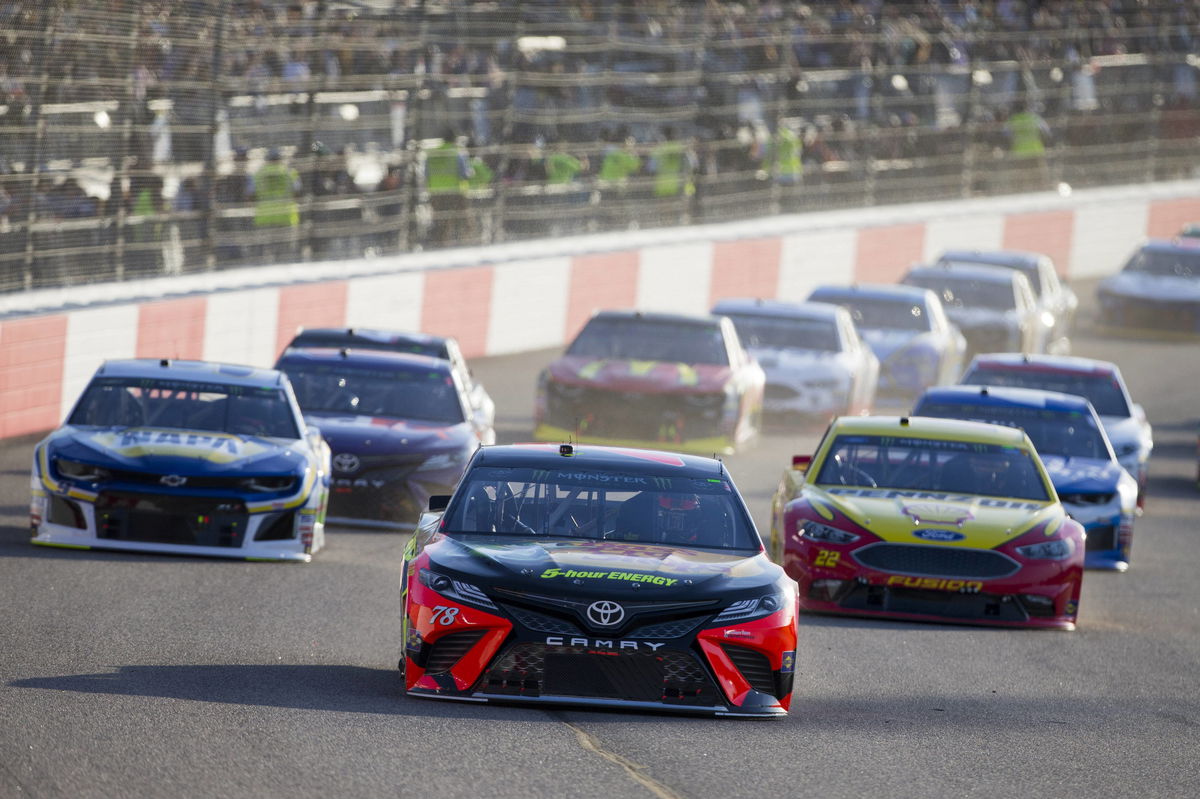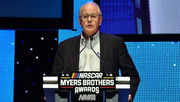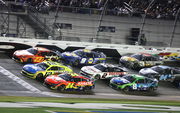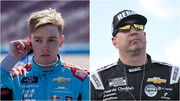
Imago
Bilder des Tages – SPORT April 21, 2018 – Richmond, Virginia, United States of America – April 21, 2018 – Richmond, Virginia, USA: Martin Truex, Jr (78), Chase Elliott (9) and Joey Logano (22) lead the field for the Toyota Owners 400 at Richmond Raceway in Richmond, Virginia. NASCAR Motorsport USA 2018: Monster Energy NASCAR Cup Series Toyota Owners 400 April 21 – ZUMAa161 20180421_zaa_a161_119 Copyright: xStephenxA.xArce/xAspxIncx

Imago
Bilder des Tages – SPORT April 21, 2018 – Richmond, Virginia, United States of America – April 21, 2018 – Richmond, Virginia, USA: Martin Truex, Jr (78), Chase Elliott (9) and Joey Logano (22) lead the field for the Toyota Owners 400 at Richmond Raceway in Richmond, Virginia. NASCAR Motorsport USA 2018: Monster Energy NASCAR Cup Series Toyota Owners 400 April 21 – ZUMAa161 20180421_zaa_a161_119 Copyright: xStephenxA.xArce/xAspxIncx
NASCAR has evolved, and the role of manufacturers in the sport has only increased over the years. Driver development has become almost as important as the raceday results, and while Chevy has the majority of teams under its roster, Ford has dominated the Next-Gen era with back-to-back championships. But Toyota seems to be playing an entirely different game altogether, one that prioritizes being clinical instead of working with volume. With just two teams, 23XI and Joe Gibbs Racing, in its roster, the Japanese manufacturer is focusing on delivering world-class talent in the stock car racing world.
Watch What’s Trending Now!
And they’ve succeeded. Over the years, we’ve seen Ty Gibbs, John Hunter Nemechek, and Corey Heim come through the Toyota Racing Development (TRD) system, which seems to be an efficient pipeline for giving a platform for the next generation of superstars. Toyota is ensuring those climbing through its ranks have a clear path to making it to the highest level and maximizing its presence in the Cup Series by treating every driver like a long-term investment.
ADVERTISEMENT
Pipeline Precision: TRD’s Tiered System
Toyota’s development ladder might be simple, but it does the job efficiently. At the entry level is Tricon Garage in the Truck Series, where promising talents such as Corey Heim and Taylor Gray are plying their trade and making a name for themselves. The Japanese manufacturer is ensuring they have competitive equipment, and the racers work closely with the TRD engineers to get maximum exposure. Top performers move to the Xfinity Series with Joe Gibbs Racing, and the legacy team gives drivers a platform to challenge for the championship, preparing them for Toyota’s flagship program in the Cup Series with 23XI or JGR.
This tiered system means aspiring Cup Series drivers have a clear path and progression system. Each national series feeds into the next one, provided a driver shows enough promise and the results to back it up. They also get access to world-class technical resources and coaching, and Toyota’s small but efficient structure means the development of a driver is streamlined. Meanwhile, Chevy has JR Motorsports, Kaulig Racing, Richard Childress Racing, and Hendrick Motorsports in its roster, but more options don’t necessarily mean a better program for young racers.
Top Stories
‘NASCAR on Sale?’: France Family’s $5B Empire in Talks to Get Sold Just Weeks After Losing Lawsuit

Jeff Gordon Distances Himself From NASCAR Fans to Defend Steve Phelps With 6-Word Statement

NASCAR Rumor: Fans Left Baffled as Insider Leaks ‘New Championship Format’ Weeks Before 2026 Season

Connor Zilisch Bets Big on Kyle Busch’s Failed Crew Chief With 5-Word Declaration

William Byron Defies His Father’s Brutal Reality Check With Bold ‘Denny Hamlin’ Confession

ADVERTISEMENT
Focus Over Volume
Toyota’s success all comes down to its discipline. Instead of having dozens of prospects in the lower series, the Japanese manufacturer focuses on having a small pool of talent. He might be Joe Gibbs’ grandson, but Ty Gibbs is their biggest success story in recent years. He raced with Toyota equipment in the Late Model Stock Car Tour, as well as the ARCA Menards Series. The North Carolina-native eventually won the Xfinity Series with Joe Gibbs Racing in his only full season in 2022, before progressing to the Cup Series the following year.
John Hunter Nemechek also revived his NASCAR career with Toyota after taking a step back from the Cup Series. After a stint with Front Row Motorsports in 2020, he used the Toyota Racing Development program to rebuild his momentum before finding himself in the No. 42 car for Legacy Motor Club. Corey Heim, who has already won eight races in the Truck Series, is also expected to find his way to the highest level, either to Joe Gibbs Racing or 23XI, in the foreseeable future.
ADVERTISEMENT
By narrowing its focus, Toyota is avoiding the mistakes Chevy has made in the past. The American manufacturer has a crowded development pool, and many of its deserving prospects often struggle to secure seats at the highest level. But Toyota’s approach is more streamlined in that regard, and they ensure that if they’re investing in developing a driver, it’s for an eventual Cup Series ride. Perhaps that’s why they’re winning the talent war.
Relationship with Teams
Another important factor that works in Toyota’s favor is its relationship with teams such as Joe Gibbs Racing and 23XI. Unlike Ford and Chevy, which have spread themselves thin across teams, the Japanese manufacturer is focused on two primary partners. This means they can be more focused when it comes to data sharing, collaboration, and aligning with the two teams when it comes to long-term goals.
ADVERTISEMENT
The results are there for all to see. Michael Jordan’s co-owned 23XI Racing has become a real force to be reckoned with ever since the team made its debut in 2021. The team directly benefits from Toyota Racing Development’s pipeline and the technical alliance they have with Joe Gibbs Racing. Both teams ensure that Toyota’s most promising drivers land competitive rides at the highest level instead of spending too long in the Truck and Xfinity Series.
It’s a stark contrast from a manufacturer like Ford, which has struggled to provide opportunities for drivers. Beyond Front Row Motorsports and the occasional Xfinity Series programs, the manufacturer has limited seats to groom young drivers at the highest level. As for Chevy, while they have plenty of teams in their roster, they lack the necessary coordination and often leave drivers fending for themselves. Toyota’s system might be comparatively smaller, but it’s a lot more efficient compared to its competitors.
ADVERTISEMENT
The Next Wave
Toyota’s development model is continuing to evolve with every passing day. After finishing runner-up last season, Corey Heim is expected to win the Truck Series championship this time around and eventually make his way to the Cup Series. As for Taylor Gray, he might not have any wins for Joe Gibbs Racing this year, but he’s another promising talent who is expected to compete against the heavyweights one day. And then there’s William Sawalich, who is finally finding his feet in the Xfinity Series with three top-five finishes in his last nine appearances.
Unlike other manufacturers, Toyota is adopting a patient approach. They’re letting drivers develop and mature before handing them a seat in the Cup Series. With Denny Hamlin in the twilight of his career, it’s well within the realm of possibility that one of these ‘prospects’ will eventually take over the No. 11 seat in the years to come. Until then, it’s important to handle these drivers with care, minimize overexposure while giving them the time to develop their racecraft.
ADVERTISEMENT
Risks and Limitations
There’s no denying that Toyota is playing a risky game. With only 23XI and Joe Gibbs Racing in the Cup Series, the manufacturer’s entire development cycle relies on the long-term stability of both organizations. With Michael Jordan and Co. currently in the middle of an antitrust lawsuit against NASCAR, and plying their trade as ‘open’ teams, their future has never been more uncertain. If either team downsizes, switches manufacturers, or struggles to remain competitive, Toyota would have nowhere else to place its rising talent.
The manufacturer’s limited footprint in NASCAR also means that there are fewer options available for drivers who are not good enough to compete in the Cup Series. One of the biggest strengths of their development programs at the moment is how streamlined the whole process is, but that could change if the corporate goals and the team’s ambitions are not in sync in the future. In comparison, while Ford and Chevy have less efficient operations, they can spread the risk across many teams, a luxury Toyota can’t afford.
ADVERTISEMENT
Conclusion – The Smartest Strategy in the Sport?
Despite the risks, Toyota’s disciplined strategy is perhaps the smartest way to go about driver development in the modern NASCAR landscape. The manufacturer is focusing on quality instead of quantity, and a clear development ladder for its ‘prospects’, and the results speak for themselves. Joe Gibbs Racing won all three Round of 16 playoff races, and Denny Hamlin looks like he’s on the verge of finally winning the Cup Series championship.
Meanwhile, Ty Gibbs won the In-Season Challenge this year, while Corey Heim looks destined to compete at the highest level one day. Toyota is changing the game, proving that precision and efficiency can be far more valuable than volume. And if the next generation of talent follows in the footsteps of the current stars, it’s fair to say that Toyota’s model will become the blueprint that other manufacturers will follow for years to come.
ADVERTISEMENT
ADVERTISEMENT
ADVERTISEMENT

